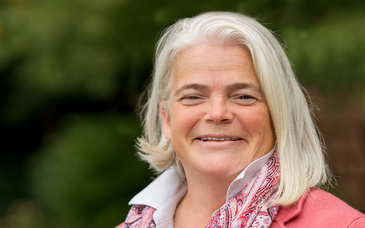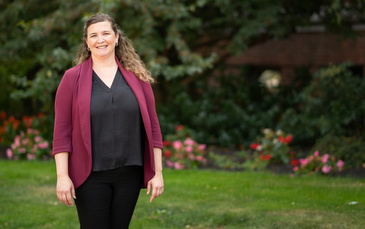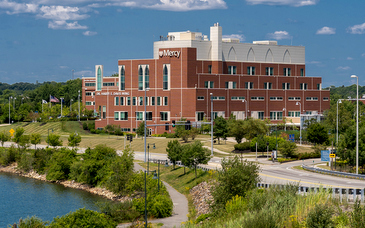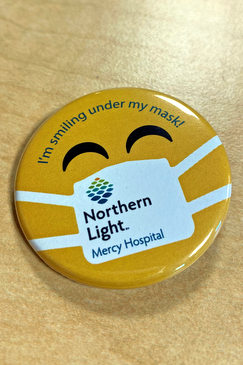Confronting COVID-19 with mercy and love

You know that soon you will likely be among those on the front lines of a global health crisis. There are questions and concerns and not a lot of experience from which to draw since the infectious assailant is one no one has confronted before. What do you do? That was the situation facing hospitals, including Northern Light Mercy Hospital in Portland, last March as they prepared for the coronavirus pandemic to hit home.
“For a group of people, like physicians, who go into this line of work because they want to help people, it’s really been a great challenge to not know the answers,” says Dr. Su-Anne Hammond, Mercy Hospital’s medical director of primary care and chief of ambulatory medicine. “This is nothing that medical school trained any physician or other clinical staff for, for the most part. None of us has been through a pandemic before. It’s a brand new virus, so you can’t go to the books.”
But what you can do is work together to find the best way forward, and that is what health-care workers and staff at Mercy Hospital were committed to doing.
“We transformed health care in a very short period of time,” says Wendy Napolitano, vice president of operations performance.
On March 2, just one day after New York reported its first coronavirus case and 10 days before Maine’s first confirmed case, Mercy activated its incident command center, a methodology used by hospitals to respond to emergency situations.
 “What that structure does is allow for key players to come together and problem solve, making sure that our patients, staff, and visitors are safe, and that we’re caring for the patients in the most appropriate way, as well as addressing a number of other things with regards to our supplies,” says Napolitano. “It’s really pulling resources together.”
“What that structure does is allow for key players to come together and problem solve, making sure that our patients, staff, and visitors are safe, and that we’re caring for the patients in the most appropriate way, as well as addressing a number of other things with regards to our supplies,” says Napolitano. “It’s really pulling resources together.”
Napolitano happened to be the administrator on call when the incident command center was activated, so she became its commander. It’s a responsibility that typically lasts 24 to 96 hours. She’s now been in the position eight months.
“We’re still in a state of emergency,” she says, referring to the state and federal emergency declarations.
The incident command team includes representatives from all areas of the hospital, including nursing, physicians, the emergency department, the lab, the pharmacy, communications, facilities, government affairs, and human resources. While normally, the team might include 10 people, in this case there were 25.
“We realized that it was critical to bring in other resources because we needed to respond so quickly. You would typically have one physician lead; we had four: ambulatory, the emergency department, our hospitalist program, and the senior physician executive,” explains Napolitano. “It was important that they participate and have the same information at the same time.
Napolitano says they realized early on the importance of continually providing accurate, updated information to staff.
“We needed to make sure we had communications cascading down to all levels of the organization, so information from incident command was the single source of truth,” she says.
Incident command meetings were initially held twice daily, some continuing for as long as 12 hours. Members faced a threefold task: how to best care for patients, how to meet the needs of staff, and how to preserve supplies.
 “How are we going to take care of our entire community as far as COVID-19 and what are we going to do to support people and keep them safe and keep them feeling supported?” explains Dr. Hammond.
“How are we going to take care of our entire community as far as COVID-19 and what are we going to do to support people and keep them safe and keep them feeling supported?” explains Dr. Hammond.
At the beginning, Dr. Hammond says there was constant research, which included reaching out to West Coast providers, where the virus hit first in the United States. Testing and the need to set up a testing site outside hospital walls emerged as a priority. The result was the creation of a drive-through site on the hospital’s Fore River campus.
“There were a group of us, six or eight of us, who were together the entire day mapping out what will it look like, how will we staff it, what will we need for resources and supplies, what is the I.T. infrastructure that we need?” says Napolitano. “That was a Thursday. On Monday, it opened to patients."
“It’s a little misleading because it looks pretty easy. You drive up in your car. You get a swab and you’re out of there in about three minutes. But, I think there are maybe six or seven different workflows that were written to make sure that the process worked that smoothly,” says Dr. Hammond.
Whether they needed a tent, heaters, Jersey barriers, or directional signs, Napolitano says the facilities department was up to the task.
“It was very collaborative,” she says.
 Due to short supplies, testing was initially limited to those who were symptomatic, health-care workers, first responders, and those who live in congregate settings. Now, it is open to anyone. To date, nearly 6,000 people have been tested there, with more than 10,000 receiving tests throughout the Mercy Hospital system.
Due to short supplies, testing was initially limited to those who were symptomatic, health-care workers, first responders, and those who live in congregate settings. Now, it is open to anyone. To date, nearly 6,000 people have been tested there, with more than 10,000 receiving tests throughout the Mercy Hospital system.
Along with the remote testing site, Mercy set up a nurse triage line to answer questions from the public. It then used its Westbrook care clinic to establish a centralized location where those with COVID-19 symptoms could go to receive a respiratory exam, a chest X-Ray, or have bloodwork done.
“That allowed us to preserve PPE when it was crucial to do so. It also allowed us to really separate the sick from the patients who were non-respiratory but still needed to see a provider in our other locations,” says Dr. Hammond. “Those were some really key things that we did early on, and those were the things that we were able to build off of."
Building off of that included going into the community to do testing and exams when COVID-19 cases emerged among the homeless population.
“We did have 'boots on the ground' at many of the homeless shelters in Portland, as well as some of the recovery centers and some of the family shelters,” says Dr. Hammond. “The State of Maine set up a shelter at a local hotel. It was for positive patients who needed to be housed, so a lot of the care that they needed was managing their COVID-19 symptoms as well as managing their chronic care.”
The visiting nurses used telehealth to connect those at the hotel and in the shelters with providers.
 With non-essential medical procedures and office visits postponed, telehealth, whether through videoconferencing or on the phone, also soon became an invaluable way for non-COVID patients to consult with their physicians.
With non-essential medical procedures and office visits postponed, telehealth, whether through videoconferencing or on the phone, also soon became an invaluable way for non-COVID patients to consult with their physicians.
“For the diabetic patient or that patient who is quarantined at home and hadn’t seen a provider but had so many questions, hearing their primary care provider on the phone, giving them some assurance, and just checking in with them was just really helpful,” says Dr. Hammond.
When it came to treating patients hospitalized with COVID-19, there was some initial uncertainty, with evolving information on symptoms and how the virus spread.
“We weren’t sure if it was caused by aerosol transmission or if it was respiratory droplets, which is a different type of transmission. Does it live on surfaces? Does it not live on surfaces? Can it be transmitted through food? Can it be transmitted through waste? All those things have evolved, and so, that’s been a challenge,” Dr. Hammond says.
One thing that became evident over time is the importance of universal masking.
“If everyone wears their mask, then you’re containing that virus within the mask. You’re not spreading it. That’s just been such an evolution from where we were in March to where we are today,” says Dr. Hammond.
While the incident command team has guided the hospital’s response, Napolitano says smaller, specialized groups were tasked with coming up with solutions to issues that arose.
“There were groups who would convene, connect together, develop a strategy and a recommendation. Those recommendations would come back to incident command, and we would have approval to move forward,” says Napolitano.
Daily huddles were held with the entire management team to share strategies and information. An open forum allowed them to ask any and all questions. Information was then passed along to staff by the managers, through emails, and on an intranet site. In addition, any physician with privileges to practice at Mercy was invited to join in Thursday night Zoom meetings. At times, more than 100 participated.
Napolitano and Dr. Hammond say a significant advantage throughout the pandemic has been its close collaboration with MaineHealth, which includes Maine Medical Center in Portland, as well as with its parent company, Northern Light Health System, and with the Maine Center for Disease Control and Prevention.
“Mercy and MaineHealth, from a local perspective, have been very close, working together to manage our patients and making sure we are consistent in our practices ,” says Napolitano.
One of the most difficult decisions, she says, was having to curtail visits from family members, some who would normally see their loved ones multiple times a day.
“We struggled a great deal with having to limit our visitors. Patients’ families and their support systems are a critical part of their wellbeing and very much a part of the decision-making and care,” she says.
 The hospital uses iPads to give patients and providers the opportunity to still engage face-to-face with their families. Nurses also seek to help fill the void, even while masked or covered in personal protective equipment.
The hospital uses iPads to give patients and providers the opportunity to still engage face-to-face with their families. Nurses also seek to help fill the void, even while masked or covered in personal protective equipment.
“It looks very foreign, and while the ‘Mercy touch’ is there, it’s different than it used to be, but I do think the staff did, and continues to do, everything possible in regards to communication and eye contact. We had buttons made for all staff that say, ‘I’m smiling under my mask,’ because our staff do that and want to convey that to patients. It was difficult and it still is, but again, I think it’s messaging through their eyes. It’s through their words. It’s through being there and listening,” says Napolitano.
Dr. Hammond says it’s been an emotional time as they try to care for their patients amid all the unknowns that come with the coronavirus.
“When you look at New York City and you look at some of the other places, I think there was just so much fear involved with not knowing how to protect our patients, protect ourselves, protect our families,” she says. “We all fear the unknown. That is human nature.”
She says one of her toughest days came at the end of March.
“March 27, I think, is the day one of my patients passed away. The patient was one of the first several in the state of Maine to pass away, and professionally, it is something that I will never forget. To grieve for a patient in the middle of a pandemic, while on an incident command team, working seven days a week, was an incredible challenge, but you push through,” she says.
Although not on the front lines herself, Napolitano shares that sense of loss.
“I think of some of the stories that we hear from our staff, those first patients who passed, how quickly the disease took over, how they reacted and responded. It brings tears to my eyes,” she says.
The hospital collaborated with Northern Light Acadia Hospital’s Behavioral Health Home Organization to offer support to workers through videoconferencing and limited in-person meetings. There were also support groups that met at various times of day, as well as an Emotional First Aid line staffed by chaplains for employees who needed someone to talk to about their concerns. The hospital also has an employee assistance program, which offers free and professional counseling.
The workers were also uplifted by the community’s outpouring of support and gratitude. Cards, posters, meals, bags of crackers, and homemade face masks were among the items sent and shared with staff. Dr. Hammond recalls an email she received during the peak of the pandemic from someone at Northern Light Health’s Presque Isle hospital.
“Somebody from A. R. Gould sent me an email and just said, ‘I want to let you know that we’re thinking about you, and my daughter’s daycare has been saying prayers for all of our family at Mercy.’ It was pretty special, pretty amazing. They followed that up with little homemade cards and beads that they sent down to us, and I shared that with staff on the front lines. I took one of those beads and put it in a place by my nametag,” she says. “It was a small gesture, but it really, really helped to provide so much strength for us.”
Hammond and Napolitano say they also draw strength from their families.
“I know that, for me, my purpose is my children. It has and probably always will be,” says Napolitano.
“Like Wendy said, for me, personally, family is everything. My kids are a little older, so knowing that I am setting an example for them of how to really work hard, to love what you do, to be passionate about what you do,” she says.
Dr. Hammond recalls being reminded during the long March days that it was a marathon not a sprint. While it’s unclear when the finish line will be reached, incident command meetings are now down to every other week with status reports given in between. Among the topics now on the table: a vaccine.
“What would a vaccination process look like? How could we manage mass vaccinations? Do we use the drive-through that we’ve established? Then, there are a lot of logistics with the vaccination itself,” says Napolitano.
Dr. Hammond and Napolitano both speak with pride about the way the hospital has met the challenges of the pandemic, just as the Sisters of Mercy did during the Spanish flu pandemic 100 years ago.
“Mercy is known as being the heart of healing, and I just feel the long days and the long hours were spent with the focus on how do we take care of our community,” says Dr. Hammond. “It’s been an incredible journey."
“I found that this experience, while one of the most difficult things, was the most rewarding as well. I’m proud of the relationships that have been even more strengthened through it which I think will carry on for some time,” says Napolitano. “I am so blessed to be part of the Mercy team.”










